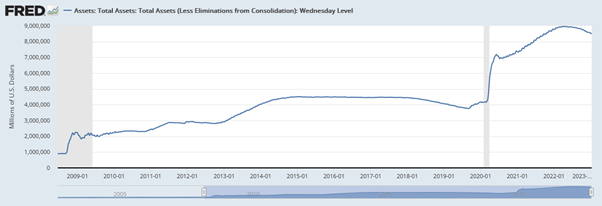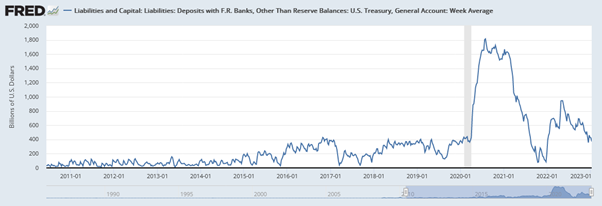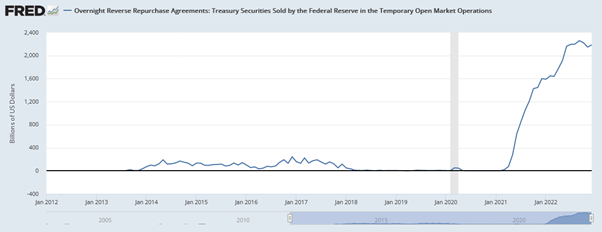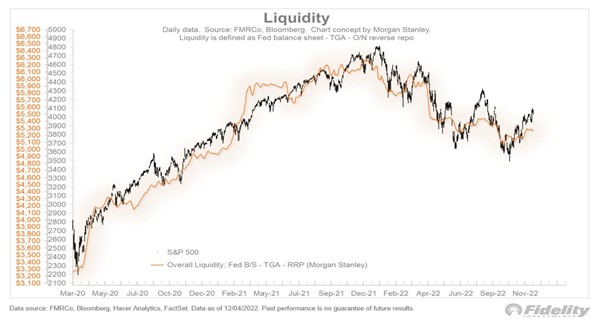Bulls beware – this rally is about liquidity, not fundamentals
With the market firing on all cylinders to start the year, it’s important to ask why.
Has the fundamental picture improved? Or is something else going on?
The obvious answer is that the market is calling the Fed’s bluff on interest rates. It’s pricing in easier than expected monetary policy this year. That’s leading to a noticeable easing in financial market conditions now.
Along with the China reopening story, the market loves this.
But the market and the economy are hardly ever in synch. The market moves ahead of the economy. And the market is also influenced by short-term liquidity flows.
And it’s this topic of market liquidity that we need to look at because it explains the recent movements in the S&P 500 nicely and will give us some clues about what comes next.
Let’s take a look…
Let’s start with QE, or ‘quantitative easing’. This is how the Fed provides monetary stimulus when the interest rate they control — the fed funds rate — is already at zero.
They do this by buying assets like US Treasury bonds and mortgage-backed securities in return for ‘fed funds’, which the Fed simply creates out of thin air. These funds – bank reserves (aka ‘liquidity’) – circulate in the financial system (but not the real economy). They lead to inflation of asset prices but not inflation in goods and services.
Fed balance sheet
The assets the Fed buys go onto its balance sheet as an asset, while the bank reserves created and injected into the banking system are the corresponding liability. The Fed’s balance sheet size is therefore a good barometer of the extent of QE.
QE was in effect from roughly 2008–15. During that time, the Fed’s balance sheet went from around US$900 billion to US$4.5 trillion. It was a very good time for risk assets in general. Most asset prices went up.
The balance sheet then stabilised for a few years before the Fed introduced the policy of QT (balance sheet shrinkage) during 2018 and 2019.
It managed to reduce its assets by around US$740 billion before it had to turn around and start buying again. It’s hard to cut the addict off from its sugar hit.
This was well before COVID too.
In January 2020, the Fed’s balance sheet was US$4.15 trillion. Then came the COVID response. Six months later, it was US$7.16 trillion. It peaked in April 2022 at US$8.965 trillion.
It had more than doubled in just over two years.
You can see the effect of QE (and a little bit of QT) on the Fed’s balance sheet since 2008 in the chart below:

The 2020–22 increase is a huge amount of liquidity to inject into the market in a short space of time. It’s why there was such a speculative boom in US assets markets especially.
As you can see in the chart above in the top right, the Fed’s balance sheet has started to shrink again. So, shouldn’t that be bearish for asset prices?
Well, yes. But there are a few other things to consider.
Treasury General Account
The post-2020 environment is a bit like the post-2008 environment in that the game has changed. The old rules don’t apply.
You can’t just look at the Fed’s balance sheet as a broad measure of financial liquidity.
COVID saw fiscal policy play a major role in getting money into the real economy.
It was only when governments started to run massive emergency deficits, financed directly by the Fed, that inflation got out of control.
This brings me to the ‘Treasury General Account’, or the TGA. When the Treasury, AKA the US government, needs funds, it issues Treasury securities in exchange for cash. Before spending the proceeds, it parks this cash at the Fed in the TGA.
In 2020, it did this on a massive scale. As you can see in the chart below, the TGA went from a balance of around US$400 billion in January 2020 to a peak of US$1.8 trillion in July.
In effect, the US Government was taking cash out of the market at the same time as the Fed was putting it in:

But that was only while the government worked out how to spend it. The TGA soon began to fall sharply as the government spent that US$1.8 trillion into the real economy. Note the sharp decline in the TGA occurred in 2021, which was the height of the speculative fervour in the US.
The point to note is that a rising TGA has a negative impact on overall liquidity, while a falling TGA injects liquidity.
Reverse repos
Now for the final piece in the overall liquidity puzzle — reverse repurchase agreements, or ‘repos’. Don’t worry, you don’t need to know the technical details of repo transactions.
All you need to know is that they’re a way for the Fed to absorb some of the excess liquidity they created in response to COVID.
Remember, the Fed’s balance sheet exploded from around US$4 trillion to nearly US$9 trillion in two years. That’s a huge amount of liquidity. They needed to absorb some of it.
They did this (and continue to do so) via the reverse repo facility. It’s basically the Fed swapping a treasury security for bank reserves, which removes liquidity from the market.
As you can see below, they’ve certainly done that since early 2021. That was when the Treasury started flooding the market with liquidity by drawing down its TGA. The reverse repo facility has gone from near zero to a peak of US$2.358 trillion in September 2022. It’s since declined to around US$2.2 trillion.
What that means is that of the Fed’s nearly US$5 trillion balance sheet expansion since January 2020, the reverse repo facility has absorbed just under half.
The chart below shows the big increase in the facility. When the line goes up, it removes liquidity from the market. When it goes down, it injects liquidity.
This facility is now a major tool for the Fed in helping to set official interest rates. So don’t expect it to fall sharply anytime soon.
But it’s also an indication of how much liquidity remains ‘on the sidelines’ in the event the Fed does lower interest rates at some point in the future:

The liquidity equation
Now, let’s put it all together to get a sense of the real net liquidity picture.
Here’s the equation:
Net liquidity = the size of the Fed’s balance sheet — TGA balance — reverse repo balance
And how does this equation correlate with the S&P 500? As you can see below, it’s a decent fit:

So while the Fed continues its policy of QT to the tune of US$95 billion per month, that’s not the only game in town. Movements in the other two accounts can have a greater or lesser effect on overall liquidity.
For example, since topping out in May around US$950 billion, the TGA has declined to a current level of US$339 million. That’s a US$610 billion liquidity injection, or more than six months’ worth of QT.
But as the chart shows, while there are ups and downs, over the past 12 months, net liquidity has declined. I expect this trend to continue.
According to my calculations, despite QT, net liquidity has increased by 3.3% from late September, which was around the major low in US markets.
This positive liquidity backdrop, along with the bullish China reopening story and the expectation that the Fed won’t be as aggressive on interest rates, have all combined to create a bullish market backdrop.
But I don’t think it will last.
Why?
For starters, the drawdown in the TGA is exacerbated right now by the debt ceiling issues. It will likely add liquidity in the short term, but once the politics of the debt ceiling play out, the TGA balance will increase, removing liquidity again.
Overall, thanks to QT of $95 billion per month, net liquidity is in a declining trend…
M2 (a proxy for US money supply to the real economy) is about to turn negative year-on-year for the first time ever…
A recession is coming. But the market is pricing in a soft landing and still positive earnings growth this year. In a recession, corporate earnings per share usually contract by 20%.
And finally, it’s only a matter of time before the Fed starts talking tough on interest rates again. Its next board meeting starting on 31 January would be a good place to start.
If you're interested in staying up-to-date with Greg’s latest insights, click this link now to get access to Greg’s publication Fat Tail Investment Advisory.
3 topics

